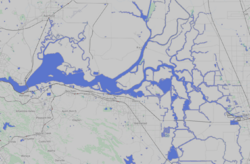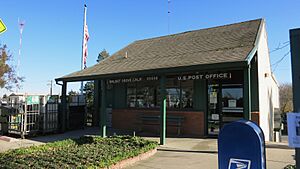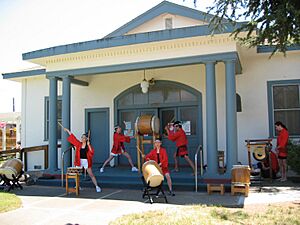Walnut Grove, California facts for kids
Quick facts for kids
Walnut Grove
|
|
|---|---|
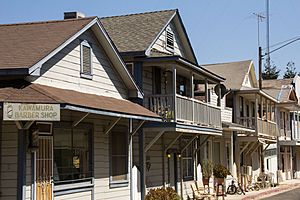
Walnut Grove Japanese-American Historic Commercial District
|
|
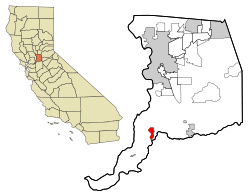
Location in Sacramento County and the state of California
|
|
| Country | |
| State | |
| County | Sacramento |
| Area | |
| • Total | 10.924 sq mi (28.29 km2) |
| • Land | 10.201 sq mi (26.42 km2) |
| • Water | 0.723 sq mi (1.87 km2) 6.62% |
| Elevation | 10 ft (3 m) |
| Population
(2020)
|
|
| • Total | 1,452 |
| • Density | 132.92/sq mi (51.320/km2) |
| Time zone | UTC-8 (PST) |
| • Summer (DST) | UTC-7 (PDT) |
| ZIP code |
95690
|
| Area code | 916, 279 |
| FIPS code | 06-83374 |
| GNIS feature ID | 1660121 |
Walnut Grove is a small community in Sacramento County, California, United States. It is called a census-designated place (CDP) because it's a special area used for gathering population data. Walnut Grove is part of the larger Sacramento area. In 2010, about 1,542 people lived there. This was a big jump from 669 people in 2000!
Contents
Where is Walnut Grove?
Walnut Grove is located at 38°14′37″N 121°30′44″W. It covers about 10.9 square miles (28.2 square kilometers). Most of this area is land, about 10.2 square miles (26.4 square kilometers). The rest, about 0.7 square miles (1.8 square kilometers), is water.
Who Lives in Walnut Grove?
In 2010, Walnut Grove had 1,542 residents. Most people, about 61.2%, were White. About 7.1% were Asian, and 1.6% were Native American. A large part of the population, 43.6%, identified as Hispanic or Latino.
There were 585 households in the area. About 31.1% of these households had children under 18 living there. The average household had about 2.62 people. Many people lived in families, with the average family size being 3.23 people.
The population included people of all ages. About 23.2% were under 18 years old. About 15.6% were 65 years or older. The average age in Walnut Grove was 40.6 years.
Walnut Grove's Past
Walnut Grove was started in 1850 by John W. Sharp. He came from Ohio with his family. He chose this spot because there were many walnut and oak trees. The town quickly grew as a farming center and a stop for riverboats.
The trees were cut down to fuel steamboats. By 1865, Walnut Grove was a major shipping port. It sent out farm products and fish. The Bartlett pear was a very important crop. By 1870, the town had many small businesses, a school, and a post office.
After John Sharp died in 1880, his family sold much of the land. Agnes Brown and her son Alex bought a large part. The Brown family became very involved in the town's businesses. They ran a general store, a hotel, and even a bank. Walnut Grove is special because it's the only town along the Sacramento River that is on both sides of the river.
A ferry used to carry people across the river. In 1916, the first bridge was built. This bridge was a special type called a cantilevered counterweight bascule drawbridge. It was the first of its kind built west of the Mississippi River.
Japanese and Chinese Communities
As early as 1914, a large Japanese community lived in Walnut Grove. They called their area "Kawashimo." There were many Japanese-owned businesses, including a tofu shop.
Before World War II, the community was separated by race. Only white people could own homes on the west side of the river. On the east side, Asian people lived in separate Japanese and Chinese sections. There were even two elementary schools: one for white students and one called Walnut Grove Oriental Elementary.
When World War II started, Japanese Americans were forced to leave the area. After they left, the two elementary schools combined.
Many Chinese residents came from two different areas in China. Those from Zhongshan lived in Locke. Those from Taishan lived in Walnut Grove. In the 1930s, during the war between China and Japan, Chinese officials visited the Walnut Grove-Locke-Isleton area. They came to raise money for the Chinese government.
The Chinese community in Walnut Grove often ran Chinese restaurants and gambling houses. These places mostly served migrant farm workers from the Philippines. White people were usually not allowed inside, in case they were police.
In the early 1930s, Walnut Grove was a busy town. But a fire destroyed the Chinese section in the mid-1930s. After World War II, the gambling operations stopped. Many Chinese residents moved to bigger cities. Many older Filipino workers returned to their home country. Today, Walnut Grove has both the Walnut Grove Chinese-American Historic District and the Walnut Grove Japanese-American Historic District.
Sugar beet harvesting was a big activity until the late 1940s. Asian women worked in fruit packing houses in the area. Men worked in the fields.
Cool Places to See
Tall Towers
Walnut Grove is home to some very tall radio and television towers. The first big tower, the KXTV/KOVR/KCRA Tower, was built in 1962. It was 1,548 feet tall! In 1985, even taller towers were built. The KXTV/KOVR Tower is 2,048 feet tall, making it one of the tallest structures in the world.
Two other towers are also very tall: the 1,996-foot-high Channel 40 Tower (KTXL) and the 2,000-foot-high Hearst-Argyle Tower. These towers are in a great spot because they can send signals over 60 miles (100 kilometers) across the flat valley. However, these very tall towers and their support wires can be dangerous for airplanes flying low.
Delta Meadows State Recreation Area
This park is located along the Railroad Slough Levee. You can get there from River Road between Walnut Grove and Locke. It's a great place to explore nature. You can even go canoeing with guides in the spring and fall.
Walnut Grove Buddhist Church
The Walnut Grove Buddhist Church is in the Japanese district. It was built in 1926 to serve the spiritual needs of the community. Before WWII, it had over 100 members. After the war, it even helped house families who had lost their homes.
Today, the church is still active. Many local people and descendants of the original members support it. They hold a popular yearly summer festival called the Bazaar and Obon. These events help raise money for the church.
Locke
Locke, California is a nearby town. It is famous for being one of the few towns in the United States built entirely by Chinese people. It was built in 1915 after a fire destroyed the Chinese section of Walnut Grove.
Locke was once a very busy place with gambling houses, stores, and a movie theater, all owned by Chinese residents. Today, Locke still looks much like it did many years ago. Most of the original buildings are still standing.
Famous People from Walnut Grove
- Bo Eason – A former football player for the Houston Oilers. He is also an actor and playwright.
- Tony Eason – A former football quarterback for the New England Patriots.
- John Garamendi – A politician who has served in the U.S. Congress. He was also California's lieutenant governor.
- Mike Honda – A former U.S. Representative and a former member of the California State Assembly.
- Kamajiro Hotta – An important Japanese immigrant farmer. People in Walnut Grove called him the "Asparagus King."
See also
 In Spanish: Walnut Grove (California) para niños
In Spanish: Walnut Grove (California) para niños


